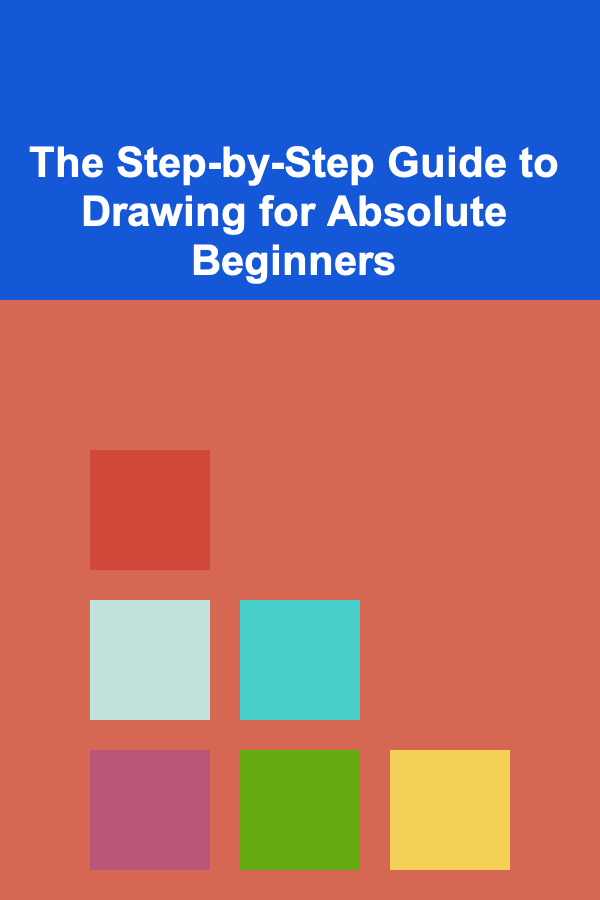
The Step-by-Step Guide to Drawing for Absolute Beginners
ebook include PDF & Audio bundle (Micro Guide)
$12.99$5.99
Limited Time Offer! Order within the next:

Drawing is one of the most accessible forms of creative expression. Whether you want to sketch as a hobby, pursue a career in art, or simply develop your creativity, learning to draw is a rewarding and fulfilling experience. For absolute beginners, however, it can be intimidating. The blank page, the pressure to get everything "perfect," and the myriad of techniques and tools can all feel overwhelming. But drawing, like any skill, can be learned with patience, practice, and the right guidance.
This guide aims to break down the process of learning how to draw into simple, manageable steps. By following these steps, you'll be able to build your confidence and skills as you embark on your artistic journey.
Step 1: Gather Your Drawing Materials
Before you start drawing, it's important to gather a few basic materials. As a beginner, you don't need to invest in expensive tools. The essentials include:
- Pencils: Start with a basic set of graphite pencils. You'll need pencils with different hardness levels. A good starter set usually includes pencils labeled H (hard), B (soft), and 2B or 4B (for darker lines). Each type will create different effects, so it's useful to have a range.
- Paper: Choose medium-weight drawing paper, preferably with a bit of texture. For starters, any basic sketchbook or printer paper will do.
- Eraser: Get a kneaded eraser (which is soft and malleable) and a regular rubber eraser. Kneaded erasers are great for lightening areas and creating soft edges.
- Sharpener: A good pencil sharpener is essential to keep your pencils in good condition.
- Ruler: While not strictly necessary, a ruler can help you with straight lines and proportions.
- Blending Tools (Optional): A blending stump or tortillon can help with shading and smoothing pencil strokes, though this can be introduced later.
Start with basic supplies, and as you progress, you can experiment with different tools and papers that suit your style.
Step 2: Understand Basic Drawing Techniques
Drawing, like any skill, involves practice and mastery of various techniques. These foundational techniques will help you develop control and precision in your drawings.
1. Line Drawing
The most fundamental aspect of drawing is line work. Lines are the building blocks of all drawings, whether you're outlining objects or adding detail. Here's how you can start practicing:
- Draw Lightly: Use light strokes when sketching to avoid making mistakes that are hard to erase.
- Vary Your Lines: Experiment with different types of lines---straight, curved, thick, thin. Understanding how to control your pencil pressure can dramatically change the look of your drawing.
- Contour Lines: These are the lines that define the edges of objects. Start by practicing simple objects like circles or squares, and focus on capturing the basic shapes.
2. Shading and Gradients
Shading adds depth and realism to a drawing. It's essential to understand how light interacts with objects to represent their three-dimensional form.
- Hatching: This technique involves drawing parallel lines close together to create shading.
- Cross-Hatching: Cross-hatching is a technique where you draw intersecting lines, creating darker shading in the intersections.
- Blending: After shading with hatching or cross-hatching, you can blend the pencil marks with your finger, a blending stump, or a tissue to create smooth transitions between light and dark areas.
3. Value and Contrast
Value refers to the lightness or darkness of an object. The contrast between light and dark areas creates emphasis, and helps define the form of your subject.
- Practice Gradients: To get a feel for value, practice creating smooth gradients. Start with a light tone and gradually build up darker tones.
- Use Contrasts: Focus on creating a clear contrast between light and dark to bring your subject to life. For example, if you're drawing an apple, make sure the bright areas of the apple stand out in contrast to the shadowed areas.
Step 3: Master Basic Shapes
The key to drawing complex subjects is breaking them down into simple shapes. Almost everything you see can be simplified into basic geometric shapes like circles, squares, rectangles, and triangles. By practicing drawing these shapes, you'll gain control over your proportions and perspective.
1. Drawing Circles and Ellipses
Circles are often the foundation of many objects (such as the head of a character, or the body of an animal). Practice drawing circles and ellipses freehand, and learn to control the symmetry of your shapes.
2. Drawing Squares, Rectangles, and Triangles
These shapes make up the structure of many objects. For example, the body of a box, the arms of a chair, and even the basic form of a building are often defined by rectangular shapes. Start by practicing these shapes in various sizes and angles.
3. Combining Shapes
Once you're comfortable with basic shapes, practice combining them to create more complex objects. For instance, a house can be broken down into a rectangle for the body and a triangle for the roof.
Step 4: Learn Proportions and Perspective
Proportions and perspective are critical in making your drawings look realistic and well-structured. These concepts help you understand the relationship between the different parts of an object and how they relate to the viewer's perspective.
1. Basic Proportions
Start by practicing drawing objects with the correct proportions. For example, when drawing a human figure, you can begin by using guidelines to mark the basic proportions of the body, such as the length of the head in relation to the torso or the arms.
2. Perspective
Perspective is the technique used to represent three-dimensional objects on a two-dimensional surface. There are several types of perspective, but beginners usually start with the following:
- One-Point Perspective: In one-point perspective, all lines converge toward a single point on the horizon. This is useful for drawing objects like roads or railways that seem to vanish into the distance.
- Two-Point Perspective: Two-point perspective uses two vanishing points on the horizon line. It is used to create depth when drawing buildings or cubes.
- Three-Point Perspective: This is a more advanced technique where lines converge toward three points. It is used to create dramatic depth, such as when drawing tall buildings from a worm's-eye view.
Step 5: Sketching from Life
Now that you've learned the basic techniques, it's time to apply them by sketching real-life objects. Sketching from life will help you develop your observation skills and improve your ability to capture proportion, detail, and perspective.
1. Start with Simple Objects
Choose simple objects like fruits, cups, or bottles to practice with. Focus on their basic shapes and practice drawing them from different angles.
2. Look for Shadows and Highlights
Pay attention to how light falls on the object and creates shadows. Notice where the highlights appear and how the shading changes depending on the object's texture.
3. Use Gesture Drawing
Gesture drawing is a technique used to capture the essence of a subject in a short amount of time. For beginners, gesture drawing helps you practice capturing motion and basic shapes quickly without focusing too much on detail.
Step 6: Practice and Develop Your Style
As you continue to practice drawing, you'll start to develop your own style. This is where your personal preferences and creative expression come into play. Your style may evolve as you experiment with different subjects, techniques, and tools.
1. Keep a Sketchbook
A sketchbook is your best tool for daily practice. Use it to try out new techniques, experiment with different subjects, and jot down your thoughts. Over time, you'll see improvement and notice patterns in your work that reflect your style.
2. Draw Regularly
The key to becoming proficient at drawing is consistent practice. Set aside time each day or week to draw. Even quick sketches will help you develop your skills over time.
3. Embrace Mistakes and Learn from Them
Don't be discouraged by mistakes. Every artist, no matter how experienced, makes them. Instead of seeing mistakes as failures, view them as opportunities to learn and improve.
Step 7: Explore Advanced Techniques
Once you feel confident with the basics, you can begin exploring more advanced drawing techniques, such as:
- Cross-Hatching and Stippling: These are advanced shading techniques that involve drawing intricate patterns or dots to create texture and depth.
- Texturing: Learn how to replicate different textures, such as fur, wood, or fabric, by manipulating your pencil strokes.
- Drawing Portraits and Figures: Practice drawing faces and human figures with accurate proportions and details.
- Coloring: If you're interested in color, you can begin experimenting with colored pencils, watercolors, or digital tools.
Conclusion
Learning to draw is a journey that requires patience, practice, and dedication. As an absolute beginner, start with simple shapes and basic techniques. Gradually build your skills as you practice sketching from life, mastering proportions and perspective, and exploring your unique artistic style. Most importantly, enjoy the process! The more you draw, the more you'll develop your creativity and confidence as an artist.
With consistent effort and a passion for learning, you can go from drawing simple sketches to creating beautiful, complex works of art. So pick up your pencil, embrace the challenges, and start drawing today!
Reading More From Our Other Websites
- [Home Cleaning 101] How to Deep Clean a Bathroom Quickly and Effectively
- [Home Pet Care 101] How to Care for Exotic Pets in Your Home
- [Paragliding Tip 101] How to Prepare a Paragliding Survival Kit for Unexpected Night Landings
- [Home Holiday Decoration 101] How to Use Vintage Holiday Ornaments to Create Timeless Decor
- [Horseback Riding Tip 101] Mastering the Canter: A Beginner's Step-by-Step Guide
- [Horseback Riding Tip 101] Choosing the Right Tack: A Guide to Saddles, Bits, and Wearables
- [Home Family Activity 101] How to Organize Family Art Exhibitions at Home
- [Beachcombing Tip 101] Best Eco‑Friendly Beachcombing Gear for Sustainable Shoreline Adventures
- [Home Cleaning 101] How to Organize Your Closet for a Simpler Cleaning Routine
- [Home Security 101] How to Keep Your Home Safe from Seasonal Threats (e.g., Winter Break-ins)

Discovering New Passions: Affordable Hobbies and Activities to Try Today
Read More
How to Incorporate Kids' Artwork into Holiday Decor
Read More
How To Style Skirts for Work and Play
Read More
How to Repair Common Swim Goggle Issues
Read More
How to Thank Your Volunteers with Heartfelt Cards
Read More
10 Tips for Families to Track Travel Expenses
Read MoreOther Products

Discovering New Passions: Affordable Hobbies and Activities to Try Today
Read More
How to Incorporate Kids' Artwork into Holiday Decor
Read More
How To Style Skirts for Work and Play
Read More
How to Repair Common Swim Goggle Issues
Read More
How to Thank Your Volunteers with Heartfelt Cards
Read More